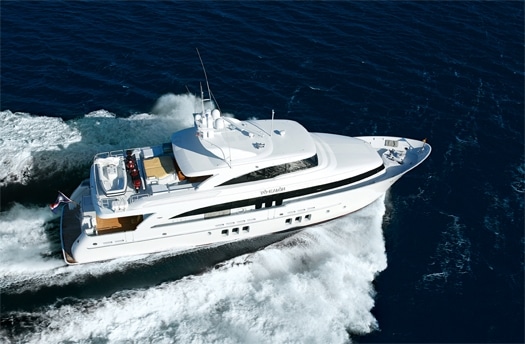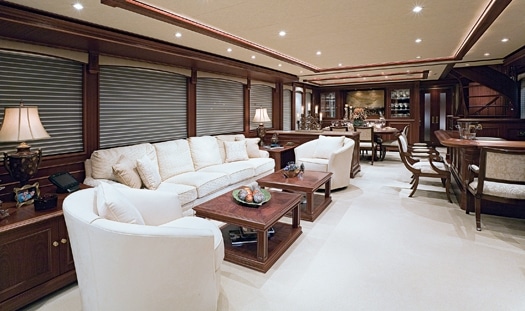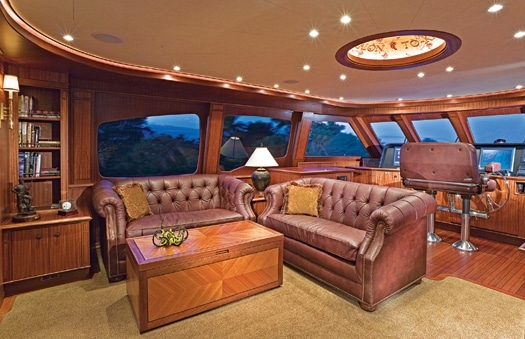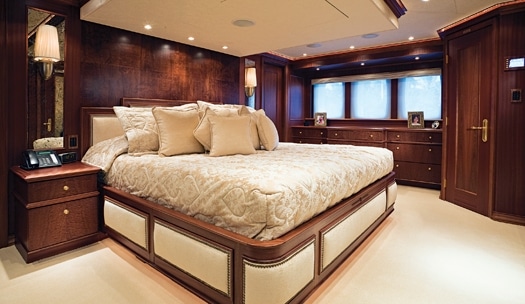
ytgjun09burger525.jpg
Accelerating a fully outfitted 101-foot motoryacht to a speed of almost 30 knots is akin to lifting the space shuttle off the ground without the benefit of rocket boosters. It takes a lot of engineering and construction wizardry to achieve such a lofty goal. So owners Dave and Cheryl Copham brought together a talented team to help ensure their recently launched Burger Tò-Kalòn is such a speed demon. The fact that she achieves the feat without fuss, and with a minimum of bow spray and wake, makes the achievement all the more impressive.
In order for Tò-Kalòn-the name is a special type of grape and a reference to the owners’ appreciation of fine wines-to meet her speed and performance goals, significant planning and the cooperation of everyone involved was paramount. The yacht was styled by Dutch designer Cor D. Rover, with an interior design by Burger and naval architecture by Donald L. Blount and Associates. These companies are consummate professionals in their particular areas of expertise. But their work on Tò-Kalòn would have been meaningless if either the builder or the owners had been unwilling to understand and accept the technical and physical realities necessary to achieve such performance.

| | |
Several decades ago, someone asked Roy Breaux, a Louisiana builder of offshore crewboats known for their speed, his secret. His straightforward bayou response: “I build ’em light and put in lots of horsepower,” is as good a guide today as it was then. A pound is still a pound, a horse is still a horse, a knot is still a knot, and the water molecules haven’t changed a bit. The design efficiency of the propulsion system and the shape of the hull are important, of course, but there’s no getting around the fact that every extra pound slows the boat.
Robert Bartee, head of Blount’s design team, was quick to praise Burger’s efforts in this regard. “Burger did well with weight control,” he said, as well as with adjustments to keep the longitudinal center of gravity within specified boundaries. In naval architecture-speak, this means that designer and builder cooperated as a team to assure the finished yacht would not only achieve the expected weight and speed, but that its response to the helm in a seaway would not yield any unpleasant surprises.
While perhaps not as well known to the general public as some yacht designers, Donald L. Blount and Associates has built an enviable reputation for designing integrated systems-hull shapes, propulsion selections, and weight targets-that deliver on performance promises. For decades Donald Blount was head of the U.S. Navy’s design team for everything up to 200 feet, and many of his talented colleagues moved into private practice with him after he left the Navy. Among their better-known projects was Destriero, the 220-foot Italian super-speedboat that crossed the Atlantic in 1992 at an average speed of 53.1 knots, without refueling. The record still stands today.
That expertise was put to work on Tò-Kalòn. While Bartee could not release the lines plan, he indicated that fairly sizeable tunnels were used to fit larger propellers for improved propulsive efficiency while still keeping the draft to a mere, Bahamas-friendly 5 feet, 5 inches. The prop tunnels, and thus the engines, are situated well outboard. This leaves room on centerline for a workbench, but unavoidably tightens things up a bit outboard of the big MTU 16V2000 engines.

| | |
The hull bottom is a fairly traditional planing surface featuring a 16-degree deadrise at the transom. Sharper sections forward soften entry into head seas and avoid pounding, and incorporate functional chine flats to keep spray to a minimum. Aft, hard chines assure clean water separation at speed to reduce resistance and maintain the necessary dynamic stability to avoid undue rolling.
Burger got a head start on weight reduction several years ago when the company became the first boatbuilder in the U.S. to use Alustar, a proprietary European aluminum alloy. The alloy has higher tensile and bending strength properties than traditional marine alloys, which means that for a given load, the aluminum can be thinner and lighter, helping to reduce structural weight.
Equally important in this program of weight control was the owners’ self-discipline. It is said that the four most dangerous words in any project, yacht construction or otherwise, are “While we’re at it ” Those words are usually followed by a seemingly simple addition that will inevitably add weight and cost, delay delivery, and degrade performance. One “While we’re at it ” is seldom fatal, but done too often, they add up to kill not only the yacht, but also relationships between the owners, the designer, and the builder. Or worse yet, between husband and wife.
There is no surer way to take the joy out of yachting-so, avoid it by having a well-developed plan and sticking to it. The Cophams understood this, having built several homes together over the years, and were comfortable working within the guidelines dictated by the physics of speed and water. When I asked Dave Copham what he would have done differently if building Tò-Kalòn again, he took an extended pause, struggling to think of something. Finally, and interestingly, he put the burden not on the builder or designer, but on himself, saying he might put a little more time and effort into advance planning, working out more of the detailed decisions before they came up.
Working out every detail in advance is not possible, of course, particularly on the interior décor. Both Dave and Cheryl worked with Burger on these details as the yacht took shape. They give credit to the builder’s design team, headed by Douglas Richey, for offering choices that satisfied the technical requirements without limiting their creativity. For instance, Burger was able to accommodate special artwork by the Cophams’ daughter, a New York artist, in the dome above the skylounge. Elsewhere, custom cast glass panels serve as shower doors, subtle marquetry adorns the headboard of the master berth, African mahogany with ebony inlays decorates the pilothouse, goldenrod granite serves as galley countertops, and the day-head sink has a stylish starfish drain. This is not a stripped-down speedboat by any measure, but rather as complete and comfortable a motoryacht as you’ll find anywhere. It’s just that she offers a nice turn of speed, too.

| | |
One design restriction that started as a limitation but turned into a blessing, according to Dave Copham, was Tò-Kalòn‘s overall length. By deed covenants, the Cophams’ home dock in south Florida is strictly limited to 101 feet, 10 inches-only four inches longer than the yacht’s actual length. “The first thing [the dockmaster] did when we arrived,” laughed Copham, “was measure the boat.” He said he and Cheryl soon discovered an unexpected benefit as they began to cruise. During their cruise, almost without exception, Tò-Kalòn was able to frequent the Cophams’ favorite marinas and resorts-the same ones they enjoyed when cruising their previous owner-operated 80-footer. The Cophams now consider 100 feet or so to be the magic number, small enough to get to places that bigger yachts can’t go, yet large enough to accommodate friends and family. They plan an extended East Coast trip this summer, the Mediterranean next summer, and Maine and Nova Scotia in 2011.
They’ll certainly be able to cover a lot of water!
Burger Boat Company, (920) 684-1600; www.burgerboat.com**; Donald L. Blount and Associates, (757) 545-3700;** **www.dlba-inc.com**









